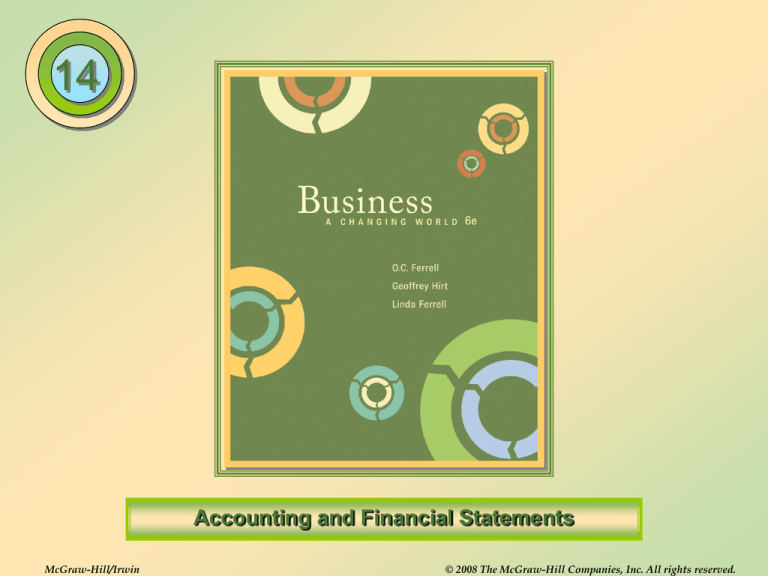
14
Accounting and Financial Statements
McGraw-Hill/Irwin
© 2008 The McGraw-Hill Companies, Inc. All rights reserved.
14-2
The Nature of Accounting
• The recording, measurement, and
interpretation of financial information, often
used in making business decisions.
Did You Know?
Corporate fraud costs are estimated at $600
billion annually.
14-3
Types of Accountants
• Public Accountant
– An independent professional who provides
accounting services to the public (individuals or firms)
for a fee
• CPA (Certified Public Accountant)
• Private Accountant
– An accountant employed by a corporation,
government agency, or other organization
• CPA or a CMA (Certified Management Accountant)
14-4
Leading Accounting Firms
14-5
Is it Accounting or
Bookkeeping?
• Bookkeepers are responsible for obtaining and
recording the information that accountants
require to analyze a firm’s financial position.
• Accountants are not only trained to record
financial information, but to understand,
interpret, and even develop the sophisticated
accounting systems necessary to classify and
analyze complex financial information.
14-6
The Users of Accounting
Information
14-7
Uses of Accounting Information
• Internal uses:
– Managerial accounting
– Cash flow
– Budget
• External uses:
– Reporting financial
performance to
outsiders
– Filing income taxes
– Obtaining credit
– Reporting to
stockholders
14-8
Internal Accounting Information
• Management
–
–
–
–
Plan and set goals
Organize
Lead and motivate
Control
• Lenders & suppliers
– Evaluate credit risks
14-9
External Accounting Information
• Stockholders and
Potential Investors
– Evaluate soundness
of investments
• Government Agencies
–
–
–
–
Confirm tax liabilities
Confirm payroll
Deductions
Approve new issues of
stocks and bonds
14-10
The Accounting Process
• The accounting equation
• Double-entry bookkeeping
14-11
The Accounting Equation
• The relationship between assets, liabilities,
and owners’ equity
Assets
Things of
value that
a firm
owns
=
Liabilities
A firm’s
debts and
obligations
+
Owners’ Equity
The difference
between a firm’s
assets and its
liabilities
14-12
Double-Entry Bookkeeping
• A system of recording and classifying
business transactions in separate
accounts in order to maintain the balance
of the accounting equation.
Assets =
$325
=
Liabilities
+ Owners’ Equity
$325
14-13
The Accounting Equation and DoubleEntry Bookkeeping for Anna’s Flowers
14-14
The Accounting Cycle
1.
2.
3.
4.
Examining source documents
Recording transactions
Posting transactions
Preparing financial statements
14-15
Financial Statements
• The end results of the accounting process are a
series of financial statements.
– Income statement
– Balance sheet
– Statement of cash flows
• Financial statements are provided to:
–
–
–
–
Stockholders and potential investors
Creditors
Government agencies
Internal Revenue Service
14-16
GAAP
• Generally Accepted Accounting Principles
(GAAP)
– Manufacturing firms, service providers, and
nonprofit organizations each use a different
set of accounting principles or rules upon
which the accounting profession has agreed.
14-17
Equivalent Terms in Accounting
14-18
The Income Statement
• A financial report that shows an
organization’s profitability over a period of
time:
– Month
– Quarter
– Year
14-19
Key Income Statement Terms
• Revenue
– Cost of goods sold
– Gross income
• Expenses
–
–
–
–
Selling, general & administrative
R&D, engineering
Interest
Depreciation
• Net income
14-20
Anna’s Flowers Income
Statement December 31, 2007
Revenues:
Net Sales:
$123,850
Consulting:
73,850
Total Revenues
$197,700
Expenses:
Cost of Goods Sold
$
72,600
Selling Expenses:
37,700
General & Admin.
18,400
Other expenses
5,600
Total Expenses
$134,300
Net Income
$ 63,400
14-21
Anna’s Flowers Balance Sheet
December 31, 2007
Assets:
Current Assets:
Cash:
Accounts Receivable
Merchandise Inventory
Total Assets:
Property & Equipment
Equipment
Office Building
Total Prop. & Equip.
Total Assets:
Liabilities & Owner’s Equity
Current Liabilities
Acct’s Payable
Total Current Liabilities
Long-term Liabilities
Mortgage Payable
Total Liabilities
Owner’s Equity:
Anna Rodriguez, Capital
Total Liabilities & Owner’s Equity
$17,850
10,200
8,750
$36,800
11,050
73,850
84,900
$121,700
$12,600
12,600
23,600
36,200
85,500
$121,700
14-22
Anna’s Flowers Annual Budget
for 2007
Sales Consulting
January
6,500
5,000
February
6,000
6,000
March
5,800
6,200
April
6,100
6,500
May
7,000
6,800
June
8,100
7,600
July
8,600
7,800
August
6,900
8,000
September
6,700
8,700
October
5,900
9,000
November
5,000
8,500
December
4,500
8,000
Annual
$123,850 $73,850
Total
11,500
12,000
12,000
12,600
13,800
15,700
16,400
14,900
15,400
14,900
13,500
12,500
$197,700
14-23
The Balance Sheet
• A “snapshot” of an organization’s financial
position at a given moment
– Presents an accumulation of all the
company’s transactions since it began
14-24
Key Balance Sheet Terms
• Assets
– Current assets
– Accounts receivable
• Liabilities
– Accounts payable
– Accrued expenses
• Owner’s equity
14-25
The Statement of Cash Flow
•
•
Explains how the company’s cash
changed from the beginning of the
accounting period to the end
Three categories:
1. Cash from (used for) operating activities
2. Cash from (used for) investing activities
3. Cash from (used for) financing activities
14-26
Analyzing Financial Statements
with Ratio Analysis
•
•
•
•
•
Profitability ratios
Asset utilization ratios
Liquidity ratios
Debt utilization ratios
Per share data
14-27
Profitability Ratios
Profit margin
=
Net income
Sales
Return on
assets
=
Net income
Assets
Return on
equity
=
Net income
Equity
14-28
Asset Utilization Ratios
Receivables
turnover
=
Sales
Receivables
Inventory turnover
=
Sales
Inventory
Total asset turnover
=
Sales
Total assets
14-29
Liquidity Ratios
Current ratio
=
Current assets
Current liabilities
Quick ratio
=
Current assets inventory
Current liabilities
14-30
Debt Utilization Ratios
Debt to total assets =
Total debt
Total assets
Times interest
earned
=
Income before interest &
taxes
Interest expense
14-31
Per Share Data
Earnings per
share
=
Net income
Number of shares
outstanding
Dividends per
share
=
Total dividends paid
Number of shares
outstanding
14-32
Industry Analysis
14-33
Solve the Dilemma
1. Describe the three basic accounting
statements. What type of information does
each provide that can help you evaluate the
situation?
2. Which of the financial ratios are likely to prove
to be of greatest value in identifying problem
areas in the company? Why?
– Which of your company’s financial ratios might you
expect to be especially poor?
3. Discuss the limitations of ratio analysis.
14-34
Explore Your Career Options
• What contributions do
accountants make to
organizations?
14-35
Additional Discussion Questions
and Exercises
1. What is the accounting equation?
– Which financial statement (income statement or
balance sheet) is most similar to the accounting
equation?
2. What is meant by the liquidity of assets?
3. In measuring a firm’s performance, many
investors and managers prefer industry
analysis or industry ratios.
– What is the advantage in using industry ratios?
14-36
Additional Discussion Questions
and Exercises
4. How do public accounts, private accountants,
and certified public accountants differ?
5. What are some different types of liabilities?
14-37
Chapter 15 Quiz
1. Which generally appears on an income statement?
a.
b.
c.
d.
Assets = Liability + Owners’ equity
Revenue - Expenses = Profit or loss
Assets - Expenses = revenue
Current assets/Current liabilities
2. An accountant who provides accounting services to
individuals and/or businesses for a fee is considered a:
a.
b.
c.
d.
certified public accountant (CPA)
public accountant
private accountant
local accountant
14-38
Chapter 15 Quiz
3. Assume a firm’s inventory turnover was 25. That
means:
a.
b.
c.
d.
the firm made a 25 percent profit on its sales.
the firm has sold and replaced its inventory 25 times in a year.
the firm has 25 items in inventory.
the firm needs to sell 25 items in inventory to make a profit.
4. The internal financial statement that forecasts
expenditures and revenues for a period is known as:
a.
b.
c.
d.
a balance sheet
an income statement
a budget
an annual report
14-39
Multiple Choice Questions
about the Video
1. Aon is a Gaelic word that means:
a.
b.
c.
d.
harmony
unity
oneness
accounting
2. Aon has offices in more than ____ countries.
a.
b.
c.
d.
12
60
120
190
14-40



